These disorders are associated with tubers which size very rapidly. Tubers may size rapidly when a rainy period follows a drought, through the improper placement of fertilizer or in fields with poor plant stands. Cultivars vary in their susceptibilities to these disorders. Kennebec is very susceptible to hollow heart and Russet Burbank is very susceptible to knobbiness. A good plant stand, proper fertilization and timely topkilling help to control these disorders.
Physiological Disorders
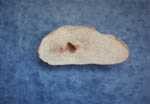
Hollow Heart
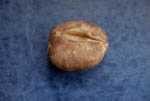
Growth Cracks
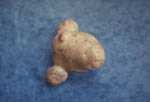
Knobs
LOW TEMPERATURE INJURY
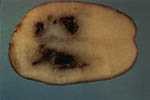
Low temperature injury may occur in the field or in storage. Injuries range from frozen tubers to chilling injury caused by prolonged exposure to temperatures slightly above freezing. Symptoms range from grey to black patches in the tuber tissue to a brown discolouration of the vascular ring. Low temperature injury results in dark coloured french fries and chips. Tubers often turn grey to black when boiled.
THUMBNAIL CRACKS

Thumbnail cracks occur at harvest or in storage. The cracks appear as if a thumbnail had been pressed into the tuber. This disorder is associated with rough handling and low humidity at harvest or in storage.
INTERNAL SPROUTING

Sprouts may grow into the tuber sometimes causing the tuber to split and to form small tubers internally. Storage at temperatures above 16 C that physiologically age the tuber or low concentrations of a chemical sprout inhibitor (chlorpropham) may cause internal sprouting.
SECONDARY TUBERS
Tubers may form beadlike tubers directly either in storage or following planting. Warm storage above 16 C or planting tubers into cold, dry soil will induce this condition. Missing hills result in the field. Physiologically old seed of Sebago and Bintje will often have this problem.
TUBER GREENING
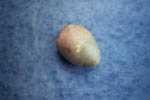
Tuber exposure to sunlight or artificial light in storage and supermarket displays causes tuber greening and is a serious problem with potatoes intended for consumption. Tuber greening may be associated with the formation of one or more bitter tasting, poisonous glycoalkaloids. Freezing or near freezing temperatures, rough handling and Colorado beetle attacks may also induce high glycoalkaloid levels without the tubers greening. Most of the glycoalkaloids are in the skin and eyes and are removed by peeling. Proper hilling, avoiding cultivars that set near the soil surface, sufficient moisture to avoid soil cracking and storage in the dark help to control greening.
GENETIC ABNORMALITIES
Wildings are potato plants that produce darker green foliage than normal, rarely flower, produce numerous stems and many more tubers than normal. Feathery wildings are another variation of this problem. The causes are unknown and control is by roguing out these plants during the seed certification process. Another abnormality, giant hill, causes potato plants to mature later than normal, grow extremely large and vigorously, produce numerous flowers. The tubers from these plants are usually few and rough. The cause is unknown and the control is via roguing. These are rarely seen in Atlantic Canada.
NUTRIENT DISORDERS
Yield reductions can occur with absences or shortages of nitrogen, phosphorus, potassium, sulphur, calcium and magnesium, which are the macronutrients essential for normal growth. Magnesium deficiency is common on coarse-textured acidic Maritime soils. Micronutrients generally considered essential include boron, chlorine, copper, iron, manganese, molybdenum and zinc. Some or all of these micronutrients may be in short or limiting supply and symptoms of shortage may resemble one or more infectious or non-infectious diseases.
In addition to deficiencies, excessive amounts of micronutrients such as boron, aluminum and manganese may cause considerable yield damage in potatoes particularly on acidic soils around pH 5.
HERBICIDE INJURY
Herbicide drift onto a growing potato crop or soil borne residues of specific herbicides, may cause significant and severe loss in the potato crop. Some potato cultivars (e.g. Shepody) are extremely sensitive to soil persistent herbicides. If potatoes are grown on land that has been treated with these chemicals, picloram in particular, in the last few years, severe yield loss and tuber malformations and stem-end discoloration may result. Such chemicals may be taken up by seed potatoes which continue to show herbicide injury symptoms even if they are grown for several generations.
STEM-END BROWNING
Stem-end browning may occur in all cultivars. The brown discoloration is usually confined to a 1 cm section at the stem end of a tuber. The disorder develops when the tops are killed rapidly (frost, chemicals, vine pulling, etc.).
BLACKHEART
Blackheart is caused by an inadequate amount of oxygen reaching tubers during growth or in storage. Tubers stored at too high or too low temperatures may develop blackheart. Development is more rapid at high temperatures. Tubers harvested from low, wet areas may also show blackheart. Proper storage temperature and good ventilation help to control this disorder.
BLACK SPOT
Black spot is a discoloration under the potato skin caused by mechanical bruises. It occurs most frequently at the stem end of the tubers. It will occur without any visible outward sign of injury; the skin need not be cut or broken. The affected areas are blue-grey to brown or black.
Low soil temperatures at harvest increase the chance of mechanical injury. When soil temperatures are below 9 C, special care should be taken in harvesting. The overall speed of harvesting should be reduced as tuber temperature becomes lower and more susceptible to injury.
Recent research has indicated that the ratios of chain speeds to forward speed in potato harvesters are influential in determining the amount of damage. Harvester operation should be such that the chains are kept full, but not filled to the extent that tuber rollback occurs.
The susceptibility of tubers to black spot will vary with season and with cultivar. Despite much research, the basic reasons which cause susceptibility to black spot injury are still unknown. However, tuber firmness and tuber temperature at handling are related to susceptibility, and increased susceptibility follows loss of tissue firmness. Basically, black spot does not develop until the tubers have been subjected to a bruising force.
Since bruising may occur during harvesting, grading and packing operations, every effort should be made to reduce the means by which injuries occur. In storage, all the evidence indicates that black spot can be controlled by proper storage management to prevent shrinkage, and by warming the tubers to 10 C prior to grading out of storage.
PRESSURE BRUISING
Pressure bruising is caused by loss of moisture from potato tubers during storage. The loss of moisture from tubers is related to storage temperature, storage humidity, rate of air movement through the potatoes, degree of sprouting and amount of mechanical damage.
To Control Pressure Bruising
- After the healing period, cool storage to desired temperature using the full capacity of the ventilation system. Ventilate only when outside air temperatures are below inside temperatures. Refer to storage section.
- When the desired operating temperature has been reached, operate system intermittently and use the minimum amount of air required to maintain this temperature.
- If moisture content of ventilating air is maintained above 90-95% relative humidity, pressure bruising will not be a problem.
- Where 90-95% relative humidity cannot be maintained, it may be advisable to add moisture to the ventilating air.
- Check storage temperatures and humidity daily. A small, accurate sling psychrometer for determining relative humidity is a good investment.
OTHER
Other non-parasitic disorders of potatoes exist such as air pollutants (sulphur oxides and ozone), insect toxins, (e.g. Psyllid sp.), soil oxygen deficiency, low temperature foliage and tuber injury, high temperature vine and tuber injury, and wind, hail and lightning injury. While these can cause losses in specific instances, they are of minor importance and are not dealt with in this guide.
